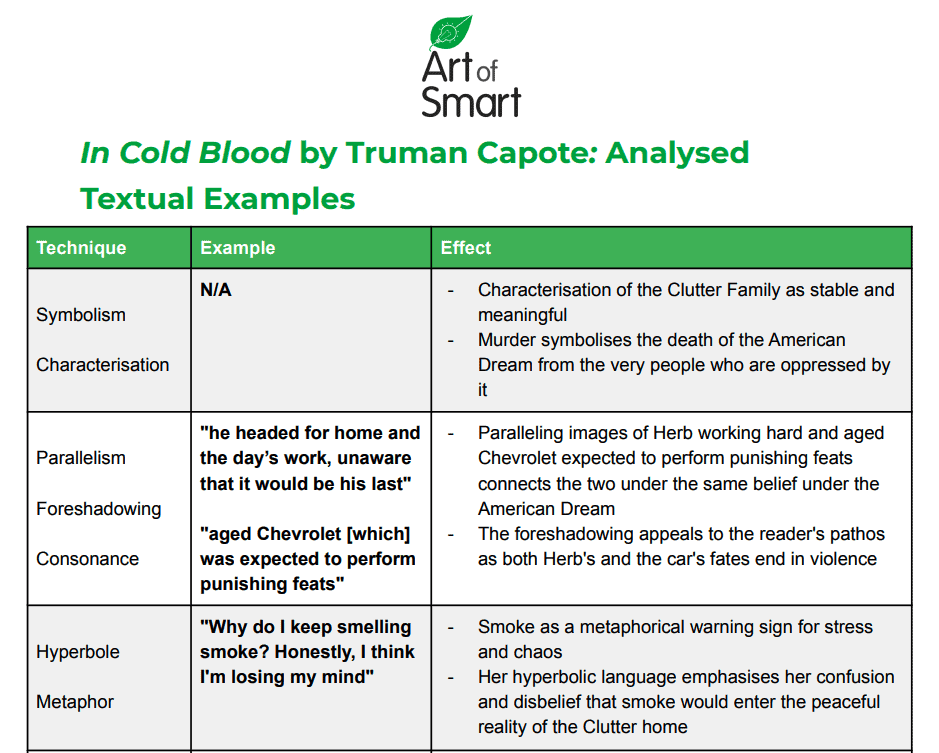Are you studying In Cold Blood for English and struggling to come up with your analysis? Looking for an all-inclusive ‘In Cold Blood’ summary? Don’t fret! We’re going to walk you through the key themes and a summary of In Cold Blood as well as give you a step-by-step of how to analyse the text.
PLUS we’ll provide you with a sample analysis table (also called a TEE table) and an example of a paragraph that gets high marks for In Cold Blood!
It’s time to ace your analysis of In Cold Blood— let’s go!
In Cold Blood Summary
Context
Themes Explored in In Cold Blood
Analysis of In Cold Blood
Studying this Text for the VCE
In Cold Blood Summary
In Cold Blood is a journalistic novel or a “nonfiction novel” about a jailhouse lie gone wrong. It weaves the stories following the murdering of the Clutter family — Herbert, Bonnie, Kenyon, and Nancy Clutter — by Richard “Dick” Hickock and Perry Edward Smith.
What is the real message and meaning behind ‘In Cold Blood’?
It includes the killer’s capture, imprisonment, the legal proceedings and their executions. Capote and his fellow friend, Harper Lee (the author of To Kill a Mockingbird), worked on the extensive project, that is In Cold Blood.
The work is divided into four titled sections, with each of them being around 75 to 100 pages long.
Part I: The Last to See Them Alive
Capote starts with the story of the Clutter Family’s last day alive. Holocomb is a rural town in western Kansas, covered by dusty roads and flat fields of wheat.
Herb Clutter, the father of the Clutter family, is working on his farm (‘River Valley Farm’). Nancy Clutter, who is Mr. Clutter’s daughter, wakes up after a late night out with her boyfriend, Bobby Rupp.
She teaches her neighbour how to bake a cherry pie and is on the phone with her friend, Susan Kidwell. Nancy also helps out her mother, Bonnie Clutter, who is emotionally unwell and suffers from ‘little spells’.
The narrator tells us that Herb is “headed for home and the day’s work, unaware that it would be his last”.
Dick and Perry pick up a black Cadillac and drive across the state. The narrator writes: “Between today and tomorrow the aged Chevrolet was expected to perform punishing feats”, foreshadowing the murder of the Clutter Family.
When they stop to buy rubber gloves and rope, Perry also wants to buy stockings to cover their heads. Dick reassures them that there will be no witnesses. Meanwhile, Herb Clutter puts down his first payment for his premium life insurance plan.
Dick and Perry have a steak dinner, keep driving into Garden City and buy a tank of gas there. Perry’s legs, which have been damaged from a motorcycle accident, are acting up and he spends a long time in the gas station bathroom.
Dick thinks Perry is having second thoughts. Nancy Clutter is making a diary entry, writing that her boyfriend watched TV with her and her brother, Kenyon, until 11PM.
Dick and Perry pull up at the Clutters’ home. The morning after, on November 15, Nancy’s friends enter the Clutter Home only to find the dead bodies of the whole family.
The murder is announced over the radio and Sunday church. The town believes it was someone from Holocomb who committed the murders.
Perry is having dinner at a hotel while Dick is at his family’s home.
Part II: Persons Unknown
The novel shifts to the perspective of the Kansas Bureau of Investigation (‘KBI’). The investigation is led by Alvin Dewey. The only clues Dewey has are footprint and a missing radio.
He suspects the murders were carried out by more than one person and speculates that they were close to the Clutters. We find out that Herb Clutter was tied down and gagged in the furnace room when he was shot in the head with his neck slit open.
Kenyon was also tied in the basement — he was on the couch and shot in the head. Bonny Clutter and Nancy were tied in their beds and shot in their heads.
Holocomb plunges further into fear.
Dick and Perry return to the eastern town of Olathe, where they first met up to commit the murders. They finance their trip by passing some bad checks and drive to Mexico City. However, soon enough, the two run out of their stolen money in Mexico, sell their car and take a bus back to America.
The narrator takes some time to reflect on Perry’s troubled childhood, where a letter from his father writes that Perry was a normal child and goodhearted if treated right.
The chapter ends on Dick and Perry, who are hitchhiking in the Mojave Desert and waiting to rob someone of their car.
Part III: The Answer
News of a reward for the information regarding the Clutter case reaches Floyd Wells. Wells worked for Herb Clutter in 1948.
He lied to Dick, his cellmate of the time, saying that Herb kept $10,000 in his safe. Realising it was probably Dick who killed the Clutters, he stepped forward to claim his reward.
With this new lead in the Clutter case, Harold Nye, another investigator of the KBI, interview Dick’s parents. They believe it was Perry, recalling that he met with Dick at their home just before their disappearance.
Dick and Perry return to Kansas city where Dick signs off some bad checks again. However, a clerk believes that the check is worthless and writes down the license plate of the stolen Chevy car that the two killers drive off in.
Dick and Perry head to Miami for Christmas. On December 30, their stolen car is recognised in Las Vegas by a local police officer and they are arrested.
Four KBI agents, consisting of Church, Dewey, Duntz and Nye, interrogate the two killers. They are separately questioned. Dick denies any involvement in the murder and Perry is upset during the interrogation.
During the next questioning, the fact that Dick’s shoes match the footprint left in the Clutter home is mentioned. Dick breaks and confesses his involvement in the crime however, maintains that Perry did all the killing.
As the killers are driven to Garden City, Perry realises that Dick has confessed (as Dewey brings up Perry’s story of killing another man that he told to Dick). Perry gives a full confession of the murders, including why and how they murdered the Clutters.
Part IV: The Corner
Dick and Perry are kept in separate cells at the Garden City Jail. Perry admits that he was the one who shot the Clutter family. He also responds to a letter from an old army friend, Don Cullivan, who wants to be Perry’s friend (and convert him to Catholicism).
Once they are found fit enough for the trial, the legal proceedings commence. They both write autobiographies for the jury to hear.
The state presents their case with the witness of Floyd Wells and the testimony of Alvin Dewey. The defence claims that Perry may have suffered from paranoid schizophrenia and could not see right from wrong.
Judge Tate finds them guilty and sentenced the death penalty, which in Kansas meant hanging. After five years, Dick and Perry are eventually hung. This takes place on Death Row in the Lansing Penitentiary, which is known as “the Corner”.
The book ends with Dewey meeting Sue Kidwell at the grave of Nancy Clutter, with the winds blowing over the Kansas grass.
Context
In Cold Blood mixes fiction with reality, exploring these tensions through the classic Southern Gothic genre.
The New Journalism Movement: What’s true and what’s not?
Capote was one of the many authors writing in the New Journalism movement of the 1960s and 1970. Rather than the objective and neutral tone typically used in journalism, it favoured a sense of intimacy and personal voice to cover stories; a famous text was Hunter S. Thompson’s “gonzo journalism” in Fear and Loathing in Las Vegas (1971).
In short, the New Journalism movement uses the genre of fiction to represent non-fictional events.
This approach mixes reality and fiction. So, undoubtedly, the reliability of ‘In Cold Blood’ is a big source of critical debate: how accurate can it really be? Capote did not use a tape recorder for any of his interviews and relied on his “impressive recall”.
He also admitted to representing Perry in a more favourable light and invented the final story of Dewey meeting Susan Kidwell at Nancy Clutter’s grave.
The idea of representing reality objectively, or the “cold hard truth”, was gradually being rejected in the larger “postmodern” movement.
Midwest American Values in the 1950s-60s
In rejecting the concept of an objective reality, Capote critiques the stable identity of the American Midwest. The sense of togetherness in the Midwest is structured by values such as nuclear family structures, traditional gender roles, Judeo-Christian beliefs, the American Dream as well as political conservatism and the belief in criminal retribution through (capital) punishment.
However, these values were also transforming and eroding. In the novel, the gruesome murders shatter Holocomb’s sense of peace and reality; fear and suspicion grow in the community. At a larger level, Capote’s fictional take on nonfictional events shatters the reader’s sense of reality.
Classic Southern gothic tale
In Cold Blood also reads like a classic Southern gothic tale, which is characterised both traditionally with horror, mystery, gruesome deaths and dark castles and also based on the land of the South haunted by its own history of slavery and violence.
Holocomb is literally called “out there”. It is isolated and desolate. The first part of the novel is most gothic: the prairie winds moan on the night that the killers drive to the innocent Clutter home. They drive through the unlit driveway lined with dark elms.
Summary of Themes Explored Throughout ‘In Cold Blood’
In Cold Blood provokes some great ideas on truth, humanity and change. Here are some themes that get you started on your thesis and topic sentences:
- The fragile nature of reality
- The complexity of human morals
- Mental illness and the importance of care
How to Analyse In Cold Blood in 3 Steps
Often students will try to start with their thesis when trying to answer an essay question. Instead, start with your analysis!
You need to equip yourself with the knowledge of your text before you can answer anything about it.
After you’ve analysed your text, you can draw ideas from it, then you can build your thesis!
We’re going to walk you through creating an analysis for ‘In Cold Blood’ in three simple steps!
Step 1: Choose your example
The best way to choose an example is to find a technique. The technique is the key to unlocking deeper meaning in a text, which you will need in your analysis.
We have chosen to look at a quote from Part I where Nancy suspects Herb is smoking:
“Why do I keep smelling smoke? Honestly, I think I’m losing my mind”
Step 2: Identify your technique(s)
When trying to find a technique within your example, it’s not about finding the fanciest technique or just any old technique for that matter!
It’s about identifying a technique which will enable you to say something about your idea that’s interesting and can contribute to your argument and analysis.
Try to focus on finding examples with techniques which unveil a deeper meaning like metaphors, similes, figurative language, connotations, symbolism and recurring motifs. Other techniques like alliteration and repetition are a bit harder to find a deeper meaning in!
We have identified 3 techniques in the quote above: rhetorical question, hyperbole and symbolism.
It’s always great to try and find multiple techniques in your quotes as it allows you to take your analysis up a notch!
Step 3: Write the analysis
When you write the analysis, it is important to always focus on what the effect of the technique is. One of the worst things you can do when writing analysis is technique labelling. Technique labelling would look like this:
Nancy’s rhetorical question “Why do I keep smelling smoke? Honestly, I think I’m losing my mind” questions her ability to understand her surroundings, where her hyperbolic language symbolises the fragility of the American experience.
Instead of this we need to flesh out how each of those techniques get us to our point. Firstly, we should flesh out what the smoke says about the Clutter family i.e. that Herb is stressed and the American Dream isn’t coming into fruition.
This stress is almost unrecognisable to Nancy, which is why she feels like she’s hyperbolically losing her mind. So if we include all that in our analysis it looks like:
However, Capote also suggests the purpose behind Herb’s hard work has long failed through Nancy’s rhetorical question “Why do I keep smelling smoke? Honestly, I think I’m losing my mind”. Her hyperbolic language shows how the mere scent of smoke lingers and breaks down her perception of a Methodist reality, as she loses her mind.
Studying this text for VCE Unit 3 – Area of Study 1: Reading and Creating Texts
If you are studying this text as a part of VCE unit 3, Area of Study 1, Reading and Creating Texts, there are a few more things to keep in mind!
One of the important aspects of this Area of Study is having your own interpretation of the text. This means that you can’t just state what is obvious about the text, instead, you need to make an argument. To have an interpretation of the text, you need to make an argument about something in the text which is not blatantly obvious.
For example, saying “In Cold Blood shows how human morality is complex” is not a strong interpretation, because that’s obvious! Everyone can see that from reading the plot synopsis. Instead, try to make your interpretations something you have to dig a little deeper than just a summary of In Cold Blood to find. For example, we have argued:
“Truman Capote’s In Cold Blood demonstrates the fallibility of human morality, where he argues that acknowledging our complexity opens up compassion and, in turn, may prevent undeserving acts of violence in the first place.”
This is a strong interpretation because it took reading into numerous quotes and signs and symbols to develop it. Below, we have explained how to come up with your own interpretation after reading the ‘In Cold Blood’ summary.
Step 1: Identify techniques in your text
Techniques are they key to unlocking the deeper hidden layers of meaning in your text, which is exactly what you want to find when developing your own interpretation.
Things like metaphors, similes, symbolism and recurring motifs are great things to look for. Things like alliteration and sound techniques will be less helpful in allowing you to uncover deeper meanings initially.
Step 2: Analyse the techniques
In this step you want to ask yourself:
- Why have they chosen to use this specific technique?
- Why was the word choice here important?
- Is there something deeper behind this quote (connections to the text, the context, the lesson readers learn)?
Step 3: Find patterns in what your analysis is saying
Once you find patterns in what your analysis is saying, or in other words, patterns in the hidden meanings within the text, you have yourself an interpretation!
For example, when we were analysing In Cold Blood, we noticed a pattern of how Perry’s childhood and dreams become a point for the reader to understand how he ends up as committing murder.
While Capote obviously does not condone his crimes, Perry’s history of being abused and humiliated demonstrates the violence within the American status quo itself, that try to break people into certain moulds.
Creative Writing
If you are studying this ‘In Cold Blood’ summary to help you write a piece of creative writing, an interpretation will be helpful in allowing you to build your own unique response to the text.
For example, since our interpretation says that acknowledging that people can fail from time to time can actually lead us to have more control and happiness over our lives, we might have a short story where a person fails most days, but succeeds on others, however is still happy no matter the outcome.
If you are doing creative writing for this assessment, it is also super important that you know about the textual features of In Cold Blood in its summary, because you will need to demonstrate you can replicate as well as alter some of these elements. We have made a list of the elements of the text below:
- Strong use of emotion
- Non-linear timeline
- Foreshadowing
- Strong use of imagery
- Strong use of metaphors and figurative language
- Fragmentary chapters
- Third person narration
- Multiple perspectives
You might also like to think of a way you can use these elements but slightly alter them. For example you won’t have fragmentary chapters in your creative writing because it will be too short, but you could instead include small fragmentary sections which change between points of view.
Looking for some additional help to understand the text better? We’ve got an incredible team of English Melbourne tutors that can help you solidify your understanding of In Cold Blood!
Need some help analysing other texts?
Check out other texts we’ve created guides for below:
Are you looking for some extra help with your analysis of In Cold Blood?
We have an incredible team of English tutors and mentors!
We can help you master your analysis of ‘In Cold Blood’ by taking you through the summary, context, key characters and themes. We’ll also help you ace your upcoming English assessments with personalised lessons conducted one-on-one in your home or online!
We’ve supported over 8,000 students over the last 11 years, and on average our students score mark improvements of over 20%!
To find out more and get started with an inspirational tutor and mentor, get in touch today or give us a ring on 1300 267 888!
Lynn Chen is a Content Writer at Art of Smart Education and is a Communication student at UTS with a major in Creative Writing. Lynn’s articles have been published in Vertigo, The Comma, and Shut Up and Go. In her spare time, she also writes poetry.












